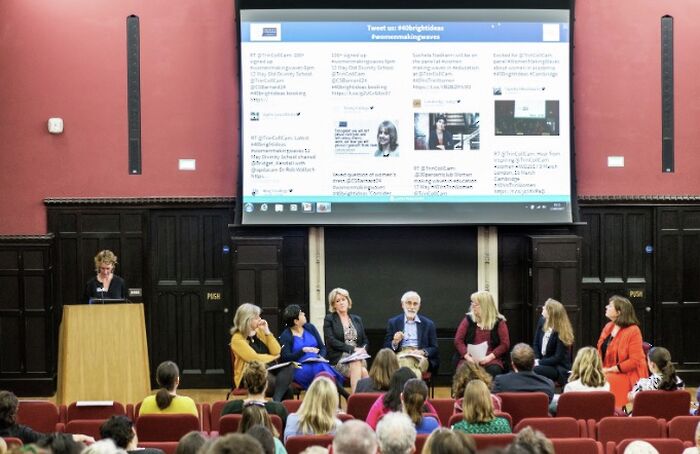When will Cambridge’s undergraduate body be gender balanced? 2020, the stats suggest
Analysis: Cambridge is highly unusual in having a majority of male undergrads. That could come to an end within a few years, if current trends continue

Recent admissions data show that Cambridge University is closing the gender gap on acceptances of males and females onto their chosen courses. In 2015 and 2016, female applicants from the maintained sector – comprehensives, grammar schools, sixth form, further education, and tertiary colleges – bucked the trend and beat their male counterparts on results day. In 2016, 50.1% of successful state school applicants were female; in 2015, this figure was even higher at 51%, with 800 making the cut in comparison to 766 males from the same educational background.
2015 is a notable year for another reason – more state-educated females than males were given offers: 994 females and 970 males. This is particularly interesting when viewing certain trends, which show that women from comprehensives are generally more reticent than men at the application stage. While, in 2016, 1,864 males from comprehensives submitted applications, just 1,389 comprehensive-educated females did the same. This has not generally been the case across the maintained sector; women applying to Cambridge from Tertiary and Further Education colleges seem more willing to take up the challenge, and in 2011, the amount of female applicants from these institutions outnumbered the males.
However, holistically speaking, women from all sectors are less likely to apply to Cambridge than men. Since 2011, hundreds more men than women have chosen to apply to the University (the latest figures from 2016 state that Cambridge received applications from 3,674 males and 2,899 females) and have, with the exception of 2015, generally received more offers across the board than their female counterparts. The most successful groups of males are those from independent schools – who beat females at the application, offer-holder, and acceptance stage – along with those who are educated overseas, regardless of educational background.
Although there have been cases of an increase in female success in individual sectors, there are currently still more men than women in the undergraduate student body at Cambridge. Women were not allowed to attend the institution until 1869, and the last all-male college to go co-education, Magdalene, did so only in 1988. The ratio of male to female undergraduates in 2016–17 was 53:47. This is the closest Cambridge has ever come to closing its gender gap.
If current trends trend were to continue – an assumed increase by 1% on the female side of the ratio, and 1% drop on the male side every two years, as admissions data demonstrates – Cambridge could potentially have an undergraduate body composed of 50% men and 50% women by 2020. In order for this to happen, the University would have to continue its encouragement of females from the maintained sector, but could also focus on supporting more women from the independent and overseas sectors, as it is here that the narrowed-down figures most clearly show an impact on the overall ratio.
How does Cambridge stack up when compared to other universities and their female acceptance rate? At Durham University, more males than females applied for 2017 entry – 559 males as opposed to 499 females, yet a higher percentage of females overall were accepted at the final stage: 54.7% of those who met their offers on 2017’s results day were women. This was similarly the case in 2016, where 55.4% of those successful were female. The University of Bristol, according to data published in 2016/17, had a cohort in which female undergraduates outnumbered male undergraduates – with 13,043 females compared to 10,984 males. However, Bristol’s subject-based data reveals another discrepancy: women dominate in Arts subjects, Social Sciences, Healthcare and Law, but males have the higher percentage in STEM subjects, such as Science, and particularly Engineering, which is studied by almost one in four male students, but only 5.14% of women.
Data from the University of Oxford for 2013 entry shows a similar higher acceptance rate of women among state-educated applicants. Of the 1,463 students accepted by Oxford from the state sector in that year, 746 were female. However, only 498 female students from the independent sector were accepted out of a cohort of 1,114.
Across the board, females seem generally more reticent to apply to the top universities, including Cambridge. The success of female students in the state sector despite this reticence demonstrates that the access schemes, which the University and its student organisations are so rightly proud of, seem to be working. However, if Cambridge truly wants to narrow the gender gap, they will have to target and encourage women from all backgrounds
 News / Pembroke to convert listed office building into accom9 December 2025
News / Pembroke to convert listed office building into accom9 December 2025 News / Uni Scout and Guide Club affirms trans inclusion 12 December 2025
News / Uni Scout and Guide Club affirms trans inclusion 12 December 2025 Features / Searching for community in queer Cambridge10 December 2025
Features / Searching for community in queer Cambridge10 December 2025 News / Uni redundancy consultation ‘falls short of legal duties’, unions say6 December 2025
News / Uni redundancy consultation ‘falls short of legal duties’, unions say6 December 2025 News / Gov declares £31m bus investment for Cambridge8 December 2025
News / Gov declares £31m bus investment for Cambridge8 December 2025









